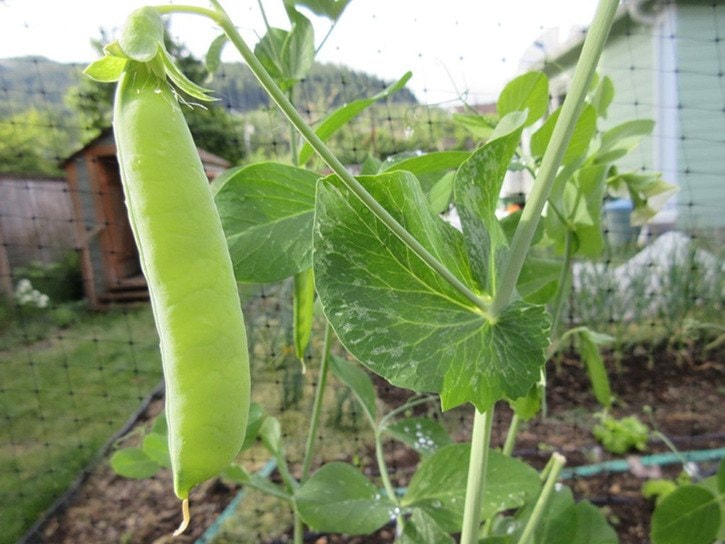Pill bugs appear to prefer fresh strawberries to anything else. David, however, prefers freshly shelled and steamed peas. He claims this is the perfect delivery medium for butter. Perhaps next year I’ll outsmart those voracious crustaceans, but for now I’m just glad for David’s sake that peas aren’t on their menu.
Peas grow best when sown directly outside, provided the slugs aren’t lurking with bated breath. If you have a raised bed that had a winter cover crop, the bed will dry out and be ready for planting earlier because the leaves of the cover crop draw water from the soil. Dig the cover crop under and let it sit for a week. Then spread one quarter inch of compost and organic fertilizer at the rate of four quarts per 100 square feet and dig this in six inches deep. At the same time, pre-sprout peas for better germination by rolling them in a damp cloth until they develop roots and plant them one inch deep into the prepared bed. I’ve used inoculants recommended for peas and never noticed any difference, so I don’t bother anymore.
Peas access nitrogen through their roots and are a low-demand crop, so this first application of fertilizer is all I give them. Most of that nitrogen ends up in the pods that we remove, so they do not return significant amounts to the soil. I spray pea plants with diluted fermented compost and kelp tea every week, but now that they’re podding, I’ll stop as I’ve read that the tea can alter their taste this close to harvest. Not that I actually drink compost tea myself, but one can infer from the aroma that it might not be an improvement.
Pick your peas when they’re nearly plump and still sweet; don’t wait for the pods to completely fill up because sugar in the peas will have turned to rather bitter starch. Once you’ve harvested the last delicious morsel, cut the plants off at the ground leaving the roots in the soil and take the plants with their remaining pods to a cool dry place under cover for a few days. Then, just like with garlic, find yourself a comfortable spot in the shade to pick all the pods off the vines. Put them into a huge bowl or two and bring them into the living room for everyone to help shell when you’re watching Jeopardy.
Let the shelled peas dry out thoroughly in a cool room, store them in cool, dry conditions and they should last all winter. These dried peas don’t take nearly as long to cook as store-bought peas because they’re fresher.
This year I’m going to try to grow a crop of peas for fall. Once the spring peas are done I’ll plant a fast-growing cover crop like buckwheat and come late July I’ll dig this in, amend the soil the same as in spring and sow quick-growing bush-type seeds like Sugar Ann or Oregon Pod II. I’ll plant these peas one and a half inches deep and place ice cubes over the top as has been suggested for summer-sown seeds, to cool things down. I’ll hand-water them every day for a week, then every two days for a week, then put them on the same schedule as the rest of the garden.
Fall just isn’t long enough hereabouts for shelling-type peas, so it’s sugar snap or sweet bush peas. I’ll try planting a second crop Aug. 15 and might still be harvesting into late November; if not, all I’ve lost is the price of a packet of seeds.
Next spring I’ll plant some bush peas along with the early climbing type so we’re eating peas sooner and look like a hero.
